
For What It’s Worth: Valuing New Cards
There has been plenty of complaining in the last month or so about how underpowered Guildpact is. Everyone complains about jank rares, like Earth Surge and all the Nephilim. I’ve been playing for ten years, and have long ago come to accept that jank happens. What still annoys me though, is that every new set brings cards that people not only initially overvalue, but overvalue DRASTICALLY. Ravnica gave us Circu, Dimir Lobotomist, and the current poster child for this phenomenon is the cute-but-worthless Quicken. Circu is a perfect example – he was a $10 card when the set first came out, and now he’s somewhere around $4, if even that. These are not terrible cards, but their initial hype far outweighs their playability – both are really casual table cards, and not worth the constructed-level prices they initially fetch. Yet hundreds of people trade away massive amounts to get playsets of cards like these at the prerelease.
Why are some cards so universally hyped and overvalued like this? What factors contribute to the initial public perception of a card’s value, and how
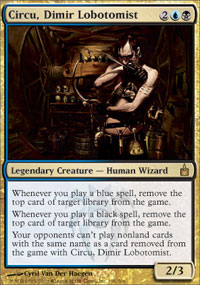
How much did you pay?
Supply and Demand
Before analyzing the phenomenon of completely new cards, we have to first understand the economic landscape that already exists. The primary factor for 90% of cards printed is what formats the cards are legal in, and how good the card in is that format – in short, the demand. Trinisphere, for example, was a powerhouse in Vintage to the point of being restricted, rendering even the mighty Moxen moot [Well... maybe not moot -Ed.], yet the card never broke $1 in value. On the other hand, Godless Shrine is only worth a few dollars less than Scrubland, and would likely be worth just as much if not more if there was a viable B/W strategy in Standard. Generally speaking, Standard legal cards have the highest demand, followed by Extended, then Legacy (I’m going to assume Vintage players have enough damned money to buy new cards at whatever price). Block formats generally don’t even factor in. If a card is unplayable in all those formats, its only value will be for collectors.
The other half of the economics equation is harder to pin down. Other than Alpha/Beta/Unlimited, Arabian Nights, Antiquities, Legends, The Dark, the Portal and Starter sets, and promotional cards like Mana Crypt, the print runs of sets have been generally large enough to handle the demand of the entire Magic community without undue strain. I define “undue strain” as “having any cards worth much more than $20.” (Other than Alliances’ Force of Will, which is so important to the Eternal formats I consider it a special case). Even tournament staples at the height of their power, like Chrome Mox, Arcbound Ravager, and Umezawa’s Jitte have not gotten much over $20, and were/are attainable by a determined trader. Many of the pricey cards from the sets listed above would not be worth so much if there were simply a reasonable amount floating around. The perfect example for this is Imperial Seal, a card that is strictly worse than Vampiric Tutor. But, because it was only printed in a set nobody bought much of (likely less than 10,000, if I had to guesstimate), that was primarily distributed in Asia, the card is worth 10 times as much as its Instant cousin. Conversely, cards reprinted frequently generally won’t be worth much at all unless they are staples – i.e., Wrath of God. And even most basic set staples are fairly cheap to acquire – Savannah Lions are played a lot in several formats, and trade very well, but can be acquired for under $5. Hypnotic Specter is even cheaper, as it was an uncommon for a long time.
Now that we’ve looked briefly at the general Magic economy, let’s look at what determines the value of a new card.
Power Level
This one is obvious. Everyone knew the Ravnica Noodles would be worth a chunk of change; we are talking about misevaluated cards. Some cards are deceptively powerful, like Quicken – players see the card, and think of such wonderful things as instant-speed Tidings and Wrath of God (and Mind’s Desire, the closest thing to a good
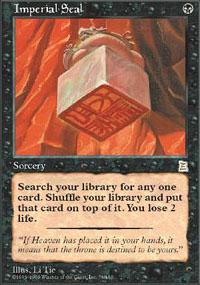
Good? Yes. Worth as much
as a Mox? I should hope not.
For the vast span of a card’s lifetime, its value will be determined primarily by Spike. But from the prerelease to the moment a set is used in a major tournament, Timmy’s voice is heard and heard so loud what few Spikes try to speak reason are drowned out. Without any tournament results to back up suppositions, vague impressions of power level are the best anyone has to go on.
Some new cards have obvious similarities to existing ones, and this is often used as the basis for initial card evaluation. The problem with this is, the power level of existing cards is revealed by the cards it interacts with, while new cards have no track record yet. Even actual REPRINTS can change in power level between printings – see old classics like Sengir Vampire and even Atog. But while reprinted cards are something of a known – and even owned – commodity, new cards based on old ones can be very easy to misjudge. “The New Wrath/Geddon/Pacifism/Bolt/Whatever” will rarely live up to the old version. Everyone knows that. It’s the cards that are strongly reminiscent of older cards – like Circu is of Meddling Mage, or Disrupting Shoal is of Force of Will – that are more difficult to assess. While there can be no hard and fast rule about cards like this, the more powerful the original card is, the more attention the new card will tend to get, whether it be negative or positive.
On the flip side of this phenomenon of overestimation, some cards go a while relatively unnoticed amidst all the clamor for ‘obviously’ powerful cards. I know that, as soon as Ravnica became available, I made it my silent mission to get playsets of Life from the Loam and Golgari Grave-Troll both – I knew Dredge would be powerful. I didn’t know specifically how, but Life from the Loam was an obvious engine in waiting (as was proven at Pro Tour LA), and Grave-Troll smelled a lot like a wonderful enabler card (Friggorid, anyone?). Neither card has seen a huge amount of play in Standard, but I’m a Legacy player at heart, and that’s the format I tend to look for cards for. Regardless, noticing the cards nobody else does before major tournaments popularize them is a difficult, but profitable, thing to do, if you can manage it. It’s hard to get a sense of what cards have this sort of potential – it is really something that comes from experience, more than something I could teach.
An easier thing to do is to look at existing cards, and figure out how new cards will effect their value. Goblin Welder was obviously a powerful card, but it didn’t have much value until Mirrodin came out and gave it all sorts of new unholy toys to play with. Accurately predicting what old cards will jump in value is tough to do – I’m still waiting for my old Domain cards to catch on in Extended – but the cards have a more stable base price
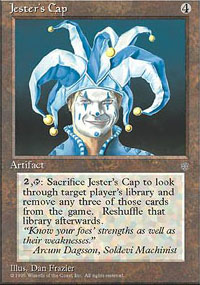
People used to hand over $20 for
this. How much did you pay for
your Cranial Extractions?
What kind of card is it?
What role would the card play in a deck? Would it be a win condition, like the almighty Meloku, the Clouded Mirror or Tooth and Nail? Would it be a support card, like Noodles and tutors, or a disruptive one like Pithing Needle? A win-more card, like Borborygmos? A combo piece or engine card, like Cloudstone Curio?
Of these, support cards tend to be the most expensive. Cards like dual lands, tutors, powerful card drawers, good removal… these cards can see play in multiple decks, and so every serious player wants to have at least a playset of them. These cards don’t often actually kill your opponent, but they make it easier for your deck to do so (or harder for your opponents).
Win Conditions come next (and combo pieces, if the combo is good enough). These are often the cards that decks are named for – Glare of Subdual, Ravager Affinity, etc. These are the flashy cards that get all the attention and respect. But, as these cards only tend to work in a few specific decks, their value is usually limited and based on the success of the deck. Enduring Ideal has never been worth as much as Tooth and Nail in its prime, but it’s never been as successful either. And Meloku is easily one of the best creatures in Standard right now, but has never been worth more than $7 or $8.
Win more cards are of little value in tournaments. The best example of a win-more card I’ve seen recently is Petrified Wood-Kin.Yes, he can be huge… but only if you’re getting huge amounts of damage through to your opponent. But as that card has been worth less than several of the uncommons in the set, I don’t think I have to make this point much.
After those categories, we have the cards made for Timmy and Johnny and even occasionally for enigmatic Vorthos. These are cards that you are most likely to groan when you open them, save in Limited tourneys. And, of course, every set has its Earth Surge and One with Nothing… but the less said about them, the better.
Now, consider our two case-study cards, Circu and Quicken. What kinds of cards are they? Neither is really a support card, though they may have aspects of them. Circu looks like he can disrupt your opponents strategy, kinda. But is either card particularly effective as a support card? Not at all – Circu costs 4, has no effect until you cast more spells, and his effect is uncontrollable and easily ended by simply killing the Lobotimist. And Quicken is only a support card, in that it lets you play a sorcery as an instant (i.e., at end of your opponent’s turn or maybe during combat) once, allowing you to keep mana open longer to disrupt your opponent and such. It looks nice on paper, but if you want disruption, run another counterspell. Those don’t require you to have sorceries sitting in your hand.
Is either card a win-condition? Circu could certainly be one. But again, we must ask – is he GOOD at it? The fact is, he’s slower to cast and more easily disrupted than Millstone, and that hasn't been used in years. Quicken, on the other hand, could perhaps be a combo piece if you had a sorcery you had to cast at a very awkward time, like during your opponent’s upkeep… and for the life of me, I can’t think of a single sorcery that could win on your opponent’s turn and not on yours.
Where does it “fit?”
Now that we know what a card does, we have to know, where will it do it? Will the card fit into existing archetypes, or would you have to build an entire new deck around it. If the later, how competitive would the deck be? This can be hard to determine, particularly for new large sets – Ravnica didn't only introduce its new cards to Standard, but it also knocked Mirrodin out, making a new Type 2 that, naturally, was unpredictable at first. But certain archetypes always have a good chance of recurring again and again – for example, U/B control.
When Odyssey when the set first came out, the chase card was easily Shadowmage Infiltrator. It was a more powerful Ophidian, and perfect for U/B control! The hype was furthered
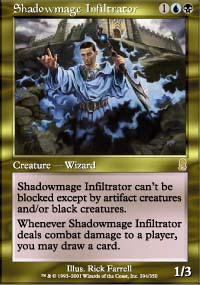
I could'a been a contender!
This area of card evaluation is where most players tend to misevaluate cards, including both Circu and Quicken. A card may have a powerful effect, like Grave-shell Scarab, and not live up to expectation simply because it doesn't find a deck to thrive in. Or, like Circu, the card may not be powerful enough to warrant building a deck around. The trick is being able to assess how effective a new card would work as the core of a new deck, and in Circu’s case, people were fooled by his passing resemblance to Meddling Mage. If stopping one card is good, stopping LOTS of cards is great, right? Not so much – Circu gives you no control over what cards he stops, meaning your opponent’s strategy can operate unhindered for some time. His milling was too slow to work alone, though I remember many excited calls to combo him with Glimpse the Unthinkable. A dedicated mill deck has yet to materialize, but even if it did, players would quickly realize that milling for 12 is not significantly more than milling for 10, and that the slots Circu would take up would be better served as removal, or card drawing… or Millstone.
Quicken has a different problem – people seem to want to throw it into existing decks, and cast their powerful sorceries at the end of the opponent’s turn. Turning Tidings into an Opportunity seems like a great idea, but you have to have both cards in your hand, all the mana untapped at the end of your opponent’s turn, and no disruption on their side. First of all, if you have a sorcery powerful enough to play in your deck, do you really want to wait until you draw Quicken to play it? If you have Quicken in your hand, and no sorceries, do you really want it to sit there as a dead card and wait for you to draw one? The idea of casting powerful sorceries at instant speed is a tantalizing one, but Quicken will fail to satisfy. Which brings me to my next point…
How easy is the card to use? Is it worth trying?
Some cards are just a lot more straightforward than others. Take Loxodon Heirarch. He’s a hyper-efficient creature. If you don’t know how to use a 4/4 creature, you need some serious help. But other cards, like Gifts Ungiven, require specific and sometimes intricate choices to be made not only when playing it, but when building a deck around it. However, Gifts has a powerful enough effect to warrant the extra effort, and it’s not terribly hard to cast. Compare it to a similar tutoring effect, Guided Passage. The ability itself is much more restrictive, making deckbuilding difficult, but what really kills it is the mana cost. You don’t want to be paying three colors of mana for a support card.
When would you want to play the card? Is it a situational card, like Shadow of Doubt or Master Warcraft? Both of the cards are fairly easy to cast, thanks to guild mana, and have potentially powerful effects, but neither is used much because the effects are only useful in situations too specific to warrant using the cards even in a sideboard slot.
Further along this vein, how easy is the card to disrupt? This is harder to answer than it looks, as it matters largely on the metagame, which is itself hard to predict when a new set comes out. Tooth and Nail was originally
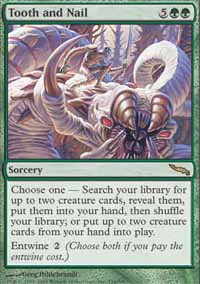
People discounted this at first.
Expensive sorceries were unusable
for a long time. That paradigm has
shifted. What will be the next one?
Let’s look back at our “friends,” Circu and Quicken. For Circu to work, you have to get him into play. Okay, that’s done easily enough. Now, for him to do anything, you have to cast a lot of blue and/or black spells, and keep him in play while you’re doing it. For Quicken, as I explained earlier, you have to have the card in hand along with a sorcery that you wish to cast as an instant, making its utility dependent entirely on what other cards are in your hand, and offering only surprise when it actually does work.
Both of these cards share a similar failing – they have little to no effect on the game state. The game isn’t measurably different after using the cards than before. You haven’t gotten card advantage, or tempo advantage, or disrupted your opponent’s strategy, or done much anything worth the card slot in your deck. Very few cards with no immediate effect on the game have ever been of much value – the only one I can think of is Cranial Extraction, which I always saw as highly overrated (What card was extracted 95% of the time? Cranial Extraction.). And even I have to admit, Extraction does at least disrupt your opponent’s strategy, immediately and, sometimes, fatally. Neither Circu nor Quicken have much impact on their own, both require the use of another card (or cards) to have any effect. Considering the logistics involved in both, the amount of effort needed to make either card work is such that you would be better off using something else if you want to be competitive.
The cards likely to be overvalued are not bad cards. Simply not or barely competitive ones. They are fine for the casual table, but it is very rare that casual popularity impacts monetary value. For example, Keiga, the Tide Star is played an awful lot as a massive, evasive, splashable win condition in Standard blue decks, while her sister Kokusho, the Evening Star isn’t nearly as played, and sometimes is left out of decks altogether in favor of Ink-Eyes and that hideous Maro-Hutt hybrid. Yet Kokusho is worth significantly more. I chalk this up to the Timmy factor – simply put, Kokusho is just damned spiffy, and far more impressive. However, this Timmy factor seems to apply mostly to Dragons – consider Cloud Dragon, which is identical to Cloud Djinn save only for scarcity and creature type. Nobody actually wants to PLAY Cloud Dragon competitively… but he’s worth the same as Keiga.
Buyer Beware
Anyway, I’ve said my piece, and may even have managed to illuminate a few people. Next time you have your first look at the spoiler for a new set, and think a card will be the next big thing, pause and think of the things I’ve said here. How powerful is the card, really? How easily can it be used, and is it worth the effort for constructed decks? What formats will it be likely to be used in, and how much? If you can answer these questions well, chances are you’ll have fewer regrets when considering your prerelease trades a month later.
VestDan is an aspiring author who is not above shameless self promotion: you can view the half-finished draft of his ridiculously long scifi/fantasy saga here
Edited by Goblinboy
Banner by nex3.
Comments